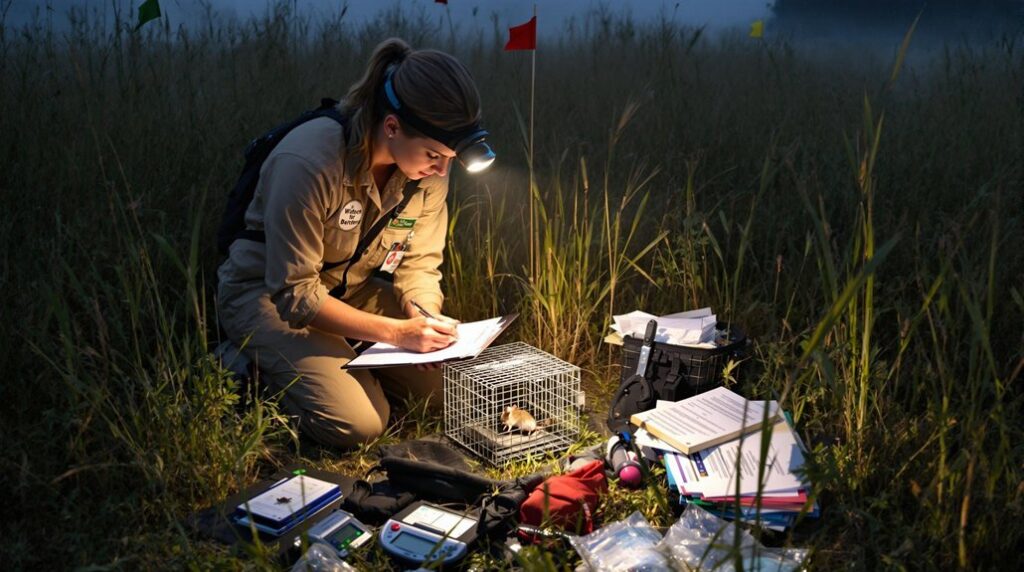To conduct a mammal survey, select methods aligned with your research goals while considering species and habitat types. Use live traps for detailed data or non-invasive options like camera traps and footprint tunnels for minimal disturbance. Create standardized sampling grids or transects, document environmental variables, and follow ethical practices when handling animals. Organize data systematically and employ appropriate statistical analyses. Proper technique combinations will greatly enhance your survey’s accuracy and scientific value.
Understanding Mammal Survey Methods and Applications
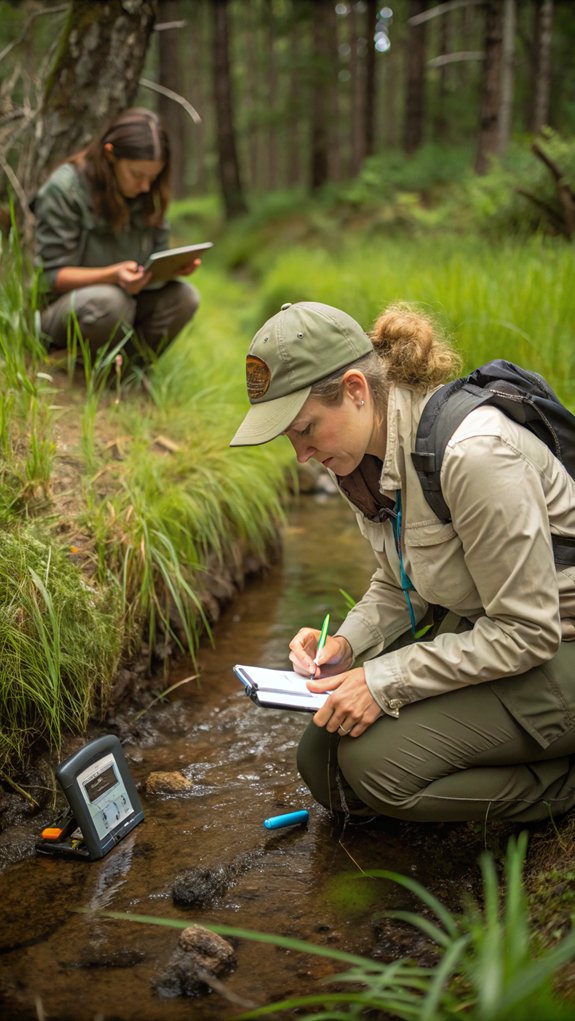
A successful mammal survey requires selecting the right monitoring technique for your specific research goals.
Active methods like live trapping provide detailed biometric data through capture-mark-recapture approaches, while less invasive options such as footprint tunnels can identify species presence without handling.
For protected species like dormice, specialized nest tubes are necessary, and licensed handling may be required.
Your survey strategy should match habitat conditions and target species.
For example: Small mammals serve as valuable indicator species for monitoring changes in agricultural landscapes and ecosystem health.
Camera traps excel at thorough inventories with minimal disturbance, while trackplates often detect carnivores more effectively.
Consider using the standardized Multiple Species Inventory and Monitoring protocols when surveying across regions.
Weather conditions greatly impact survey effectiveness—rain can compromise footprint detection and trackplate functionality.
To maximize reliability, combine multiple techniques and supplement with habitat characterization data.
Remember that surveyor training directly affects identification accuracy, so invest in proper field guides and reference materials before beginning.
Planning Your Survey: Site Selection and Sampling Design
Effective site selection forms the foundation of any successful mammal survey.
Begin by creating detailed vegetation maps showing native plant communities, water bodies, and key terrain features. Identify critical microhabitats like caves or tree hollows that target species might use.
Stratify your survey by habitat type, guaranteeing you’ve included representative samples of each vegetation alliance. You’ll want to establish clear study boundaries using GIS tools and prioritize rare or ephemeral habitats that may host endemic species.
Consider both temporal and spatial factors in your design. Schedule surveys during ideal detection periods—avoid extreme weather conditions and align with species-specific activity patterns.
For thorough coverage, deploy systematic sampling grids or transects that incorporate microhabitat features.
Include replicate sites to account for seasonal variability and maintain consistency by standardizing methods across your team.
This approach guarantees scientifically robust data that can be compared across time and locations.
Essential Equipment for Different Mammal Survey Types
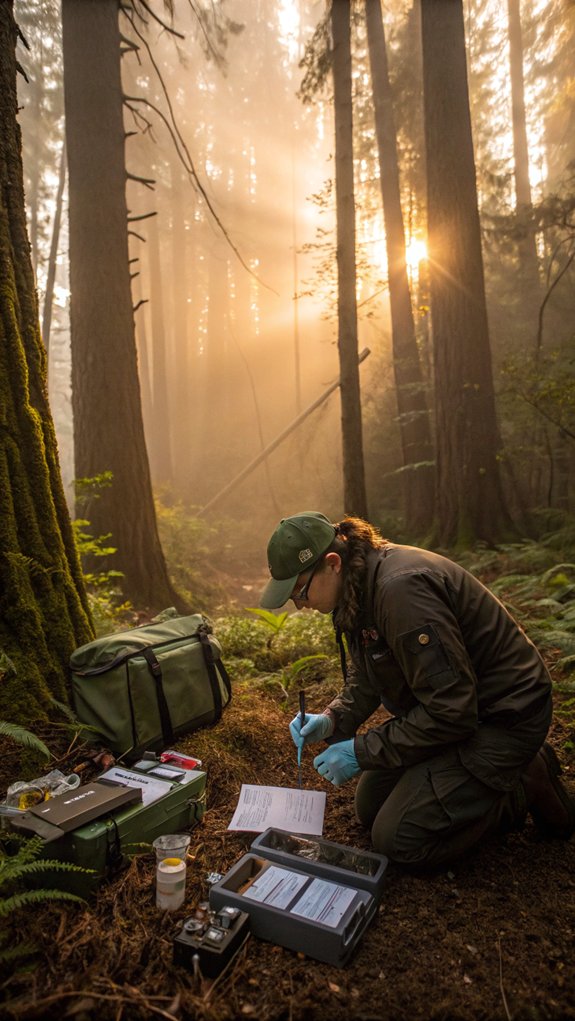
Because mammal surveys require specialized gear tailored to target species, selecting the right equipment is essential to your survey’s success.
For small mammals, choose between Longworth traps (durable with detachable tunnels) or Sherman traps (lightweight, foldable) alongside spring scales and protective gloves.
When seeking non-invasive methods, footprint tunnels with ink pads work well for hedgehogs and dormice, while squirrel surveys benefit from specialized hair tubes that differentiate between red and gray species. Equipment selection should align with seasonal restrictions that apply to protected species surveys.
For broader habitat assessment, deploy camera and trackplate arrays strategically—position trackplates at centerpoints with cameras at varying distances. These systems are particularly effective for detecting bears and mesocarnivores during 10-day sampling windows.
Don’t forget supplementary tools: binoculars for daytime observation, electronic detectors for locating traps, mist nets for bats, and radio collars for tracking larger mammals’ movement patterns.
Live Trapping Techniques and Animal Welfare Considerations
Live trapping represents the cornerstone of mammal survey methodology, though its successful implementation requires careful attention to both technical efficiency and animal welfare.
When selecting trap types, consider that Sherman traps capture more species but mesh live traps offer higher success rates for rodents. Pitfall traps excel at catching semi-fossorial species like shrews.
You’ll need to check traps frequently to prevent mortality from exposure or stress. Always provide bedding material such as hay and make certain traps are well-ventilated.
When handling animals, use gloves and calm procedures to minimize stress and injury.
Pre-bait your traps for three days before active trapping to enhance capture rates. Space trap stations approximately 8m apart in a grid pattern for ideal coverage.
Remember that combined methods—like supplementing live trapping with camera surveys—will improve detection accuracy, especially for elusive species.
Always obtain proper licenses when working with protected species.
Non-Invasive Methods: Camera Traps, Hair Samples, and Footprint Tunnels
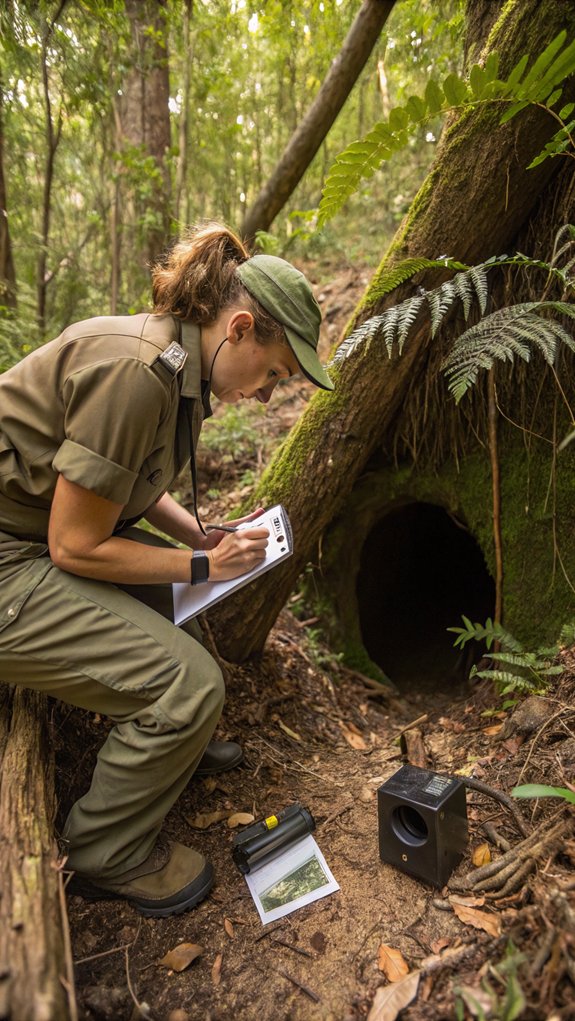
Non-invasive monitoring methods offer three primary advantages over live trapping: reduced stress to animals, decreased field labor, and continuous data collection.
When using camera traps, place them along trails or near water sources using systematic or random sampling designs. Consider rotating locations periodically and using baits to increase detection rates.
For hair sample collection, utilize naturally deposited materials or hair-snagging devices. DNA analysis from these samples provides species identification and population data without handling animals.
Footprint tunnels employ ink pads and tracking paper with bait to capture small mammal prints. They’re quicker to check than camera traps and particularly useful for presence/absence surveys and public engagement. The lightweight design of tunnels makes them easily transportable to various field locations.
Each method has limitations: cameras may miss cryptic species, hair samples require laboratory analysis, and footprint tunnels work primarily for smaller mammals.
Consider your study objectives, budget constraints, and target species when selecting the most appropriate non-invasive technique for your survey.
Field Signs and Visual Encounter Surveys
Field signs and visual observations provide reliable mammal detection methods without specialized equipment. When conducting transect walks between 08:20-14:30, particularly in winter months, you’ll need to identify key indicators like latrines, feeding remains, and burrows.
Look for water vole droppings in piles near waterways and chopped vegetation at feeding stations.
For effective surveys, walk consistent transects (averaging 127.6m) multiple times to reduce detection bias. Record both direct sightings and field signs simultaneously, ensuring accurate species identification to prevent data misrepresentation. GPS-tag all observations for precise documentation.
While visual encounter surveys excel at detecting diurnal species, they’re best paired with other methods for nocturnal animals. When resources are limited, field sign surveys offer rapid assessments with less labor than camera trapping. These traditional survey methods remain labour-intensive but economical compared to newer technologies.
Pay special attention to species-specific signs like otter tracks, badger setts, and carnivore latrines which follow distinct spatial patterns.
Data Collection, Recording, and Storage Protocols
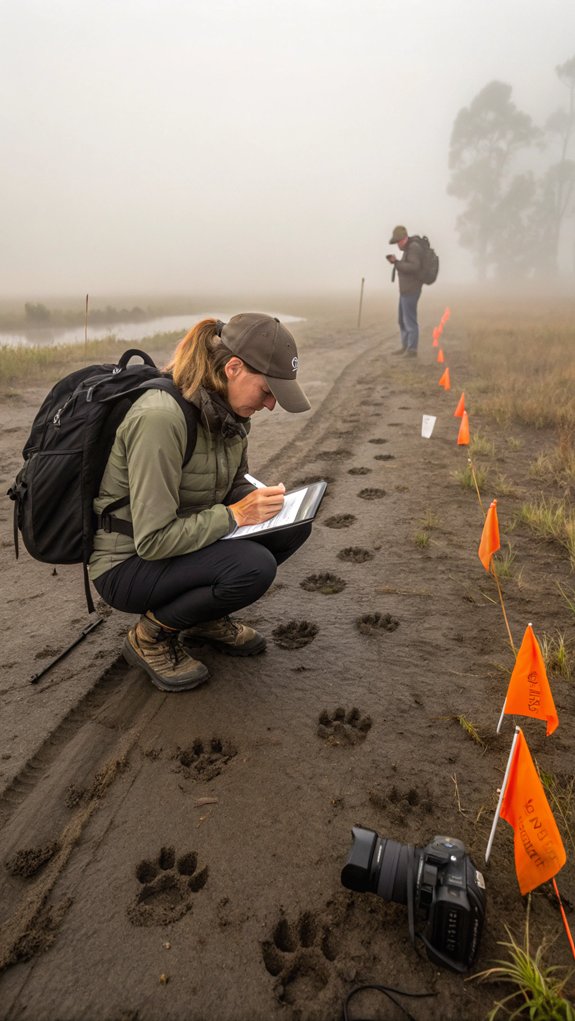
Effective mammal survey success depends entirely on robust data collection, recording, and storage protocols that guarantee scientific validity and reproducibility. Implement standardized field methods that include transect sampling with measured observer distances, camera trap grids strategically positioned during peak activity times, and live-trapping using Sherman traps in 90x90m grids with 100 traps per site.
Record environmental variables during collection, adjusting protocols based on lunar cycles and weather conditions to minimize animal stress. For biological sampling, maintain consistent handling procedures, collect DNA material from hair snares or scat, and preserve samples at appropriate temperatures. When processing captured mammals, assess them for tick quantity and life stage to monitor potential disease vectors.
Document data using both field notebooks and electronic devices, ensuring all entries include precise taxonomic information, GPS coordinates, and habitat descriptions.
Store your data in redundant systems using hierarchical databases that include metadata descriptions and standardized naming conventions to facilitate future analyses and collaborative research.
Statistical Analysis and Population Estimation
Once you’ve collected your mammal survey data, proper statistical analysis becomes essential for extracting meaningful population estimates and ecological insights.
Select the appropriate estimation method based on your survey goals—mark-recapture for detailed population structure, distance sampling for density calculation, or camera trapping with Random Encounter Models when individual recognition isn’t possible.
Utilize specialized software like DISTANCE or R programming to analyze your data. Calculate key statistical indices such as Shannon-Wiener for diversity measurement and implement bootstrapping to generate reliable confidence intervals.
Remember to account for detection probability by incorporating runtime likelihoods and surveyor competence assessments. Many large mammal species are difficult to accurately count due to their natural camouflage and mobility across varied terrain.
For robust results, validate your findings through multiple complementary methods.
Concurrent track surveys can provide rapid presence data while camera trapping yields more detailed records over time. Cross-reference your methods to identify potential biases and adjust your population estimates accordingly.
Legal Requirements and Conservation Implications
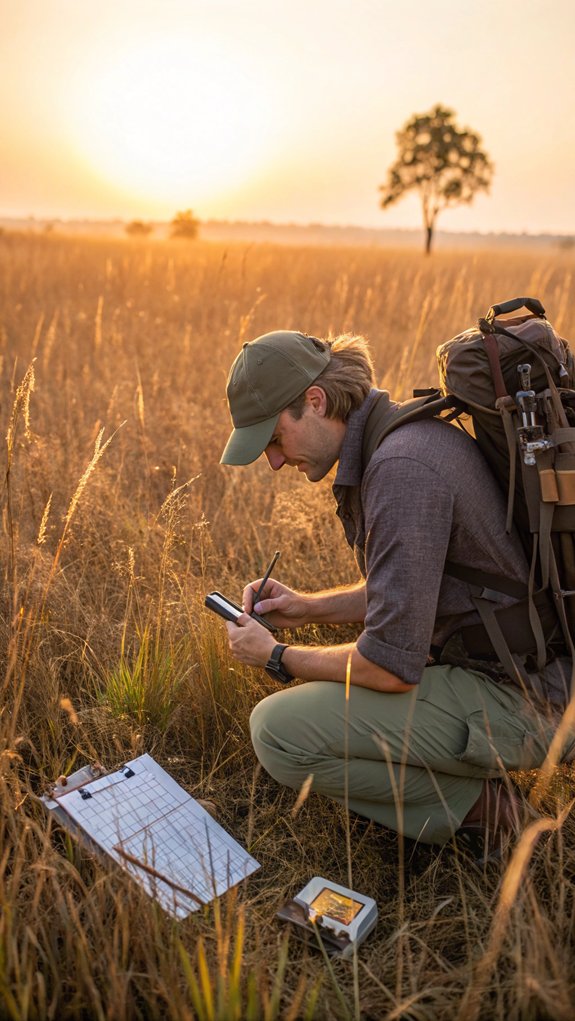
Before undertaking any mammal survey, you’ll need to navigate a complex web of legal requirements that vary by region and species status. Register your research facility under the Animal Welfare Act (§2136) if you’re handling animals directly.
For marine mammals, understand MMPA harassment definitions – both Level A and Level B prohibit activities that could disrupt natural behaviors.
When working with endangered species, familiarize yourself with ESA protections including critical habitat designations and recovery plans that may affect your survey methods. Establish an Institutional Animal Care and Use Committee (IACUC) to review your protocols for ethical compliance, especially important for wildlife-specific guidelines.
Coordinate with relevant jurisdictional authorities – NOAA Fisheries oversees marine mammals, while the Fish and Wildlife Service handles terrestrial and some aquatic species. The Marine Mammal Commission may also provide oversight depending on your survey targets. Consider implementing trail camera sampling as a non-invasive method that preserves habitat integrity while still gathering valuable data.
Combining Methods for Comprehensive Mammal Monitoring
Combining multiple monitoring techniques yields far more thorough results than any single method can provide on its own.
Consider pairing trackplate arrays with camera stations to detect both carnivores and herbivores at varying distances, while visual encounter surveys contextualize these findings with habitat data.
For ideal detection, cross-validate indirect methods with direct observations. Deploy camera traps in tunnel setups and supplement with photogrammetry for body size estimation. When monitoring specific functional groups, tailor your approach accordingly—trackplates and cameras work well for carnivores, while camera surveys paired with habitat mapping suit herbivores. For marine mammals, photogrammetry offers a non-invasive method to analyze body condition and reproductive status without disturbing the animals.
Implement multi-stage sampling over 3-year cycles with 5-year resampling periods to balance costs with ecological relevance. Use hexagonal buffers (200m radius) around monitoring points for standardized sampling.
For low-detection species, combine live trapping with genetic sampling methods like hair tubes to maximize identification while minimizing animal stress.
References
- https://www.nhbs.com/en/blog/nhbs-guide-to-small-mammal-survey-equipment
- https://wac.colostate.edu/docs/books/writingspaces1/writing-spaces-readings-on-writing-vol-1.pdf
- https://www.mooc-conservation.org/assets/courseware/v1/54c7fa8b34a8299e3afa8ab29861cc9f/asset-v1:IUCN-Papaco+MOOC-SE+EN-1+type@asset+block/M3_L6.pdf
- https://www.aupress.ca/app/uploads/OER-202302_Chamberlain_Dubberlboer_2023-Read-Think-Write.pdf
- https://academic.oup.com/biohorizons/article/4/1/40/238741
- https://www.cloudbridge.org/wp-content/uploads/2011/09/2010-Medium-Large-Mammals-Cailly-Duffay-Mazille-Eng.pdf
- https://pce-fet.com/common/library/books/51/2590_[Paul_D._Leedy
- https://www.agriculture.gov.au/sites/default/files/documents/survey-guidelines-mammals.pdf
- https://apps.dtic.mil/sti/tr/pdf/ADA508442.pdf
- https://www.sandiego.gov/sites/default/files/legacy/planning/programs/mscp/pdf/biosurveyguidefull.pdf

Erzsebet Frey (Eli Frey) is an ecologist and online entrepreneur with a Master of Science in Ecology from the University of Belgrade. Originally from Serbia, she has lived in Sri Lanka since 2017. Eli has worked internationally in countries like Oman, Brazil, Germany, and Sri Lanka. In 2018, she expanded into SEO and blogging, completing courses from UC Davis and Edinburgh. Eli has founded multiple websites focused on biology, ecology, environmental science, sustainable and simple living, and outdoor activities. She enjoys creating nature and simple living videos on YouTube and participates in speleology, diving, and hiking.
🌿 Explore the Wild Side!
Discover eBooks, guides, templates and stylish wildlife-themed T-shirts, notebooks, scrunchies, bandanas, and tote bags. Perfect for nature lovers and wildlife enthusiasts!
Visit My Shop →
